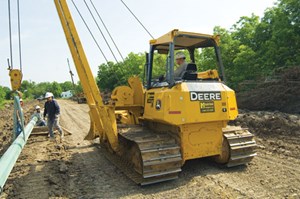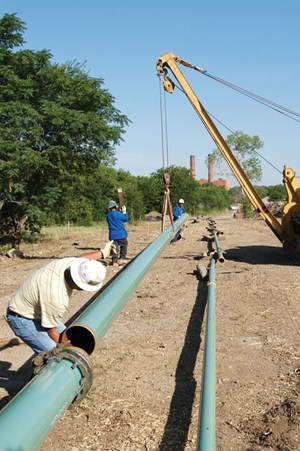January 2022 Vol. 77 No. 1
Features
2022 Energy Pipeline Construction Outlook
By Jeff Awalt, Executive Editor
Oil and natural gas prices climbed higher in 2021, prompting increased drilling and production among mostly independent producers in global regions, but a host of political and COVID-related economic concerns kept markets on edge and highly reactive for much of the year.
While an improved upstream outlook had positive implications for the midstream sector, global pipeline construction remained comparatively sluggish as project developers maintained a cautious approach, with capital spending aimed primarily at projects already underway.
A consensus among industry analysts calls for oil and gas prices to remain relatively strong and continue to drive strong upstream cash flows in 2022. But midstream benefits are expected to remain limited as many producers focus on shoring up their balance sheets and increasing shareholder returns.
These trends were reflected in our annual analysis of pipeline construction activity, which found 103,324 miles of pipelines either planned or under construction worldwide at the start of 2022. Of those, 71,495 miles represent projects in the engineering and design phase, and 31,829 miles are in various stages of construction.
The figures reveal an 8.8 percent decline in total mileage compared with the 113,305 miles of pipelines that were planned or under construction in our 2021 survey.
Total mileage was either flat or down in every region, compared with the year-earlier survey, with the North America and Asia-Pacific regions posting the largest declines – though for varying reasons.
NORTH AMERICA
Pipeline Miles Under Construction: 4,044
Pipeline Miles Planned: 17,841
Total: 21,885 (2022 expectation: decline of 13.4 percent)
Pipeline construction activity in North America remains soft overall after a multi-year period of rapid capacity expansion ran head-first into the market collapse of 2020.
Since then, environmental and political challenges to large midstream projects have only grown as U.S. President Joe Biden’s administration has taken a more adversarial stance toward all fossil fuels in pursuit of stricter national climate policies – a shift that became clear with the effective cancellation of the Keystone XL project on his first day in office.
S&P Global Ratings revised its midstream industry risk assessment downward to intermediate risk from low-risk in 2021, incorporating the “increasing environmental and social risks posed by climate change, greenhouse gas emissions, and the use of hydrocarbons over the longer term.”
All these factors have steered U.S.-dominated North American midstream construction away from major greenfield projects and toward more upgrades and expansions of existing systems. On the other hand, the difficulty in building new infrastructure is increasing the value of existing pipelines and infrastructure, and that trend is making the U.S. midstream sector ripe for more consolidation.
In fact, one of the clear industry trends of 2021 was a move among U.S. utility companies to sell or spin off their midstream assets in order to focus capital spending within their lower-risk, regulated businesses. In one of the largest of these transactions, Energy Transfer acquired 100 percent of Enable Midstream Partners from CenterPoint Energy and OGE Energy. In another, DEl sold its gas transmission and storage assets to Berkshire Hathaway Energy.
Construction continues
It would be easy to take a dim view of North American midstream prospects based on these high-profile events, but despite challenges, there is still a substantial level of construction planned or underway by historical standards and many analysts maintain a positive outlook for the sector.
“Despite the ongoing transition to a lower carbon intensive economy, we expect that existing midstream assets will continue to be needed over the next several decades because the U.S. will continue to rely on the consumption of hydrocarbons to meet most of the country’s energy needs,” S&P wrote. “As such, we expect that the midstream industry will continue to play a critical role in the broader energy value chain.”
North American pipelines under construction during 2021 included natural gas projects that added more than 4 Bcf/d of new capacity in the United States during the third quarter, primarily supplying Gulf Coast and Northeast demand markets.
The largest of those, NextEra’s 450-mile, 42-inch Whistler natural gas pipeline was completed in July, adding 2 Bcf/d of capacity from the Permian Basin at the Waha Hub in West Texas to the Agua Dulce Hub. Located in Southeast Texas, the Agua Dulce Hub is a supply point for pipelines crossing the states southern border into Mexico.
Upon partial completion in August, the Acadiana Expansion added 894 MMcf/d of takeaway capacity to Kinder Morgan’s Louisiana intrastate pipeline, which delivers natural gas from the Haynesville Basin to the Sabine Pass LNG terminal. The full project is slated for completion during the first half of 2022.
Other additions came from the Cameron Extension Project on the Texas Eastern Transmission (TETCO) interstate pipeline, which feeds the Calcasieu Pass LNG terminal, and Portland Natural Gas Transmission System’s Westbrook Xpress Phases 2 and 3, which added 81 MMcf/d of capacity from Canada to New Hampshire. A new compressor station in Westbrook, Maine, will add another 50 MMcf/d of capacity.
Among the more ambitious U.S. projects unveiled in 2021, Navigator CO2 Ventures announced plans to construct a 1,200-mile carbon capture pipeline system designed to capture and store 12 million tons of CO2 per year. The project, which would span five states, is supported by the BlackRock Global Energy & Power Infrastructure Fund, and Valero is the anchor customer, Navigator said.
But the second half of 2021 also saw a continuation of North American pipeline delays and cancelations. In late September, PennEast Pipeline announced that it would stop developing its 120-mile, 1.1 Bcf/d natural gas pipeline from Pennsylvania to New Jersey despite winning a U.S. Supreme Court ruling in a lawsuit allowing it to seize state-owned or -controlled land in New Jersey.
As recently as August, PennEast said it still hoped to finish the first phase of the pipeline in 2022, although it still lacked a water quality certification in New Jersey and other permits. Originally, PennEast had hoped to finish the project in 2019.
Canada
In Canada, work is continuing into 2022 on two high-profile oil and gas pipeline projects and new and expanded export facilities on its Pacific Coast.
TC Energy’s Coastal GasLink project continued to make progress and reached the 50 percent completion mark in the second half of 2021, despite numerous delays caused by Indigenous protests and legal challenges.
Upon completion, the 416-mile pipeline will deliver natural gas across Northern British Columbia to the LNG Canada facility now under construction in Kitimat, B.C. LNG Canada’s Joint Venture Participants include Shell, Petronas, PetroChina, Korea Gas and Mitsubishi Corporation.
Also in Western Canada, expansion of the government-owned Trans Mountain Pipeline is making steady progress. The expansion is essentially a twinning of the existing 715-mile pipeline between Strathcona County, near Edmonton, Alberta and Burnaby, B.C. It will create a pipeline system with the nominal capacity of the system going from approximately 300,000 bpd to 890,000 bpd. Export capacity from Burnaby is also being expanded.
Mexico
In addition to recent pipeline expansions that increase the capacity for natural gas imports from the United States, Mexico has also been investing in a comprehensive expansion of its domestic pipelines and power generating facilities to meet electricity demand in growing regions of the country. The Cuxtal Project in Mexico’s Yucatan region is a centerpiece of the expansion.
Energía Mayakan, which has operated Engie’s 497-mile gas pipeline since 1999, began construction in 2021 of the series of pipeline expansions. The next phase will increase pipeline capacity to than 500 MMcf/d to serve five existing generation plants and two future plants, and the final phase will extend the Mayakan gas pipeline to connect the city of Vallaloid to Cancun with a 106-mile,240 MMcf/d pipeline. Construction is expected to take a little more than two years. •
Worldwide construction plans
Asia-Pacific/Australia
Pipeline Miles Under Construction: 10,007
Pipeline Miles Planned: 10,911
Total: 20,918 (2022 expectation: Decline of 13.6 percent)
Africa
Pipeline Miles Under Construction: 1,668
Pipeline Miles Planned: 15,016
Total: 16,684 (2022 expectation: Decline of 1 percent)
South/Central America
& Caribbean
Pipeline Miles Under Construction: 2,789
Pipeline Miles Planned: 13,441
Total: 16,230 (2022 expectation: decline of 1 percent)
Russia & CIS
Pipeline Miles Under Construction: 6,930
Pipeline Miles Planned: 8,018
Total: 14,948 (2022 expectation: Decline of 5.9 percent)
Western Europe/EU
Pipeline Miles Under Construction: 3,513
Pipeline Miles Planned: 4,160
Total: 7,673 (2022 expectation: Decline of 8.8 percent)
Middle East
Pipeline Miles Under Construction: 4,100
Pipeline Miles Planned: 886
Total: 4,986 (2022 expectation: Decline of 4.3 percent)






Comments